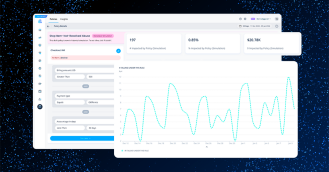We’re all chasing that one brand that gets it. The shoes that fit right, lasts more than two years, and look good. You’ve seen them everywhere, and then boom – an ad in your favorite color. Checkout took less than three minutes, with no hassle or extra steps. Even the promo code worked. That’s a personalized customer journey — relevant, seamless, and rewarding. It made you feel understood, and now they’ve earned your loyalty.
Most digital leaders strive to provide experiences like this — tailored, dynamic, and quick. But these are the same features that fraudsters exploit. So, how do you create frictionless, personalized experiences without exposing yourself to vulnerabilities?
It’s a risk. But with best practices and strategies in place for secure personalization, it’s possible even without losing good customers.
Your Customers Expect Personalization
Today’s customers no longer just appreciate personalization — they expect it. Brands that deliver relevant, customized experiences see higher engagement, retention, and revenue. Here are 4 ways personalization can enhance your customer’s journey:
- Tailored Products: Using AI to suggest relevant items or recommendations to increase purchase likelihood
- Seamless Checkout: Remembering payment preferences and streamlining repeat purchases to increase customer experiences
- Personalized Promotions: Targeting discounts and offers to customers based on past behavior
- Dynamic Pricing: Adjusting prices based on browsing history, demand, or loyalty status
These strategies make shopping easier and more engaging, but they also open the door to new fraud risks.
Personalization: The Potential Risk at Hand
Fraudsters see those personalization features as opportunities to exploit those systems for their own financial gain. Sometimes personalization can lead to:
- Promo & Referral Abuse: Bots and fraud rings exploit sign-up bonuses, VIP perks, and one-time discounts
- Synthetic Identities: Fake profiles are created to game personalized discounts, promotions, or referral programs
- Account Takeovers (ATOs): Stolen credentials let fraudsters hijack accounts, drain rewards, and misuse loyalty perks
You get the challenge — how do we stop fraud without creating friction for real customers?
Best Practices for Secure Personalization
You need systematic ways to implement a data-driven approach to deliver personalization without risk. Here are 4 best practices to help you strike a balance between security and a seamless customer journey:
Leverage Identity Intelligence
Knowing your customer goes beyond a login. Dynamic identity insights help confirm whether a user is who they claim to be, making it harder to exploit your systems under your nose.
Monitor Behavioral Analytics
Fraudsters leave little red flags as they go: erratic login attempts, promo code abuse, and high-risk account activity. Tracking users’ behavior, not just who they are, makes it easier to flag suspicious activity when it matters most.
Avoid Rigid Fraud Rules
Fraud tactics evolve fast, and static rules can’t keep up. The smarter approach? Automated, adaptive fraud prevention that spots synthetic identities, emerging threats, and anomalies without increasing false positives.
Secure Personalization is a Competitive Advantage
You get it. Secure personalization isn’t just about reducing your risk — it’s also about building trust and driving growth.
With the right approach, businesses can verify users discreetly, keeping fraudsters out without disrupting good customers.
- Trust Increases: When customers know their accounts are secure
- Frictionless Checkout: Boosts conversion rates
- Fraud Defenses: Strong barriers to prevent abuse before it ever happens
- Loyalty Grows: When security feels invisible and easy to customers
Personalize Without Compromise
Personalization keeps customers engaged, but trust keeps them coming back. As a digital leader, you don’t have to choose one or the other; you just need to make them work together.
That’s where identity intelligence, behavioral analytics, and adaptive abuse prevention come in. They work together to create personalized, frictionless customer journeys without exposing vulnerabilities.
When personalization is done right, customers feel understood, checkout is effortless, and fraudsters never make it past the front door. The brands that master this balance go beyond reducing risk. They earn loyalty, boost conversions, and build lasting relationships.



